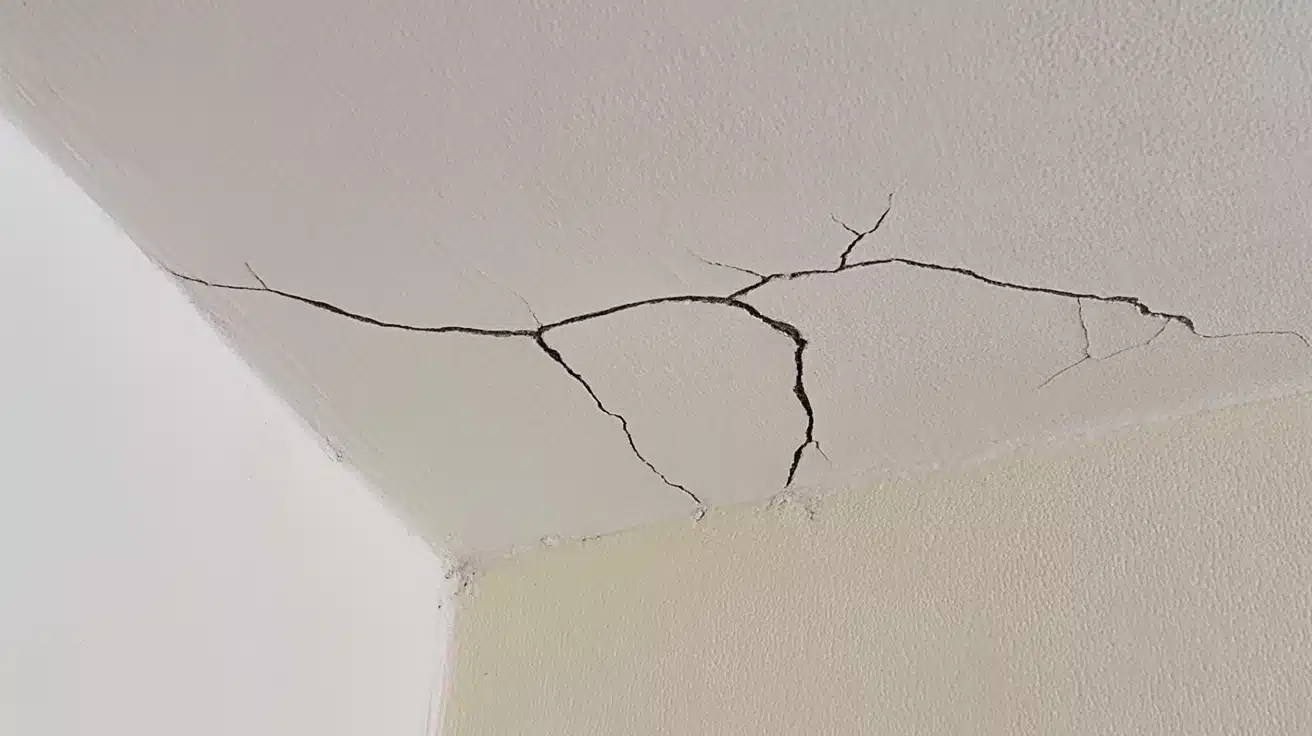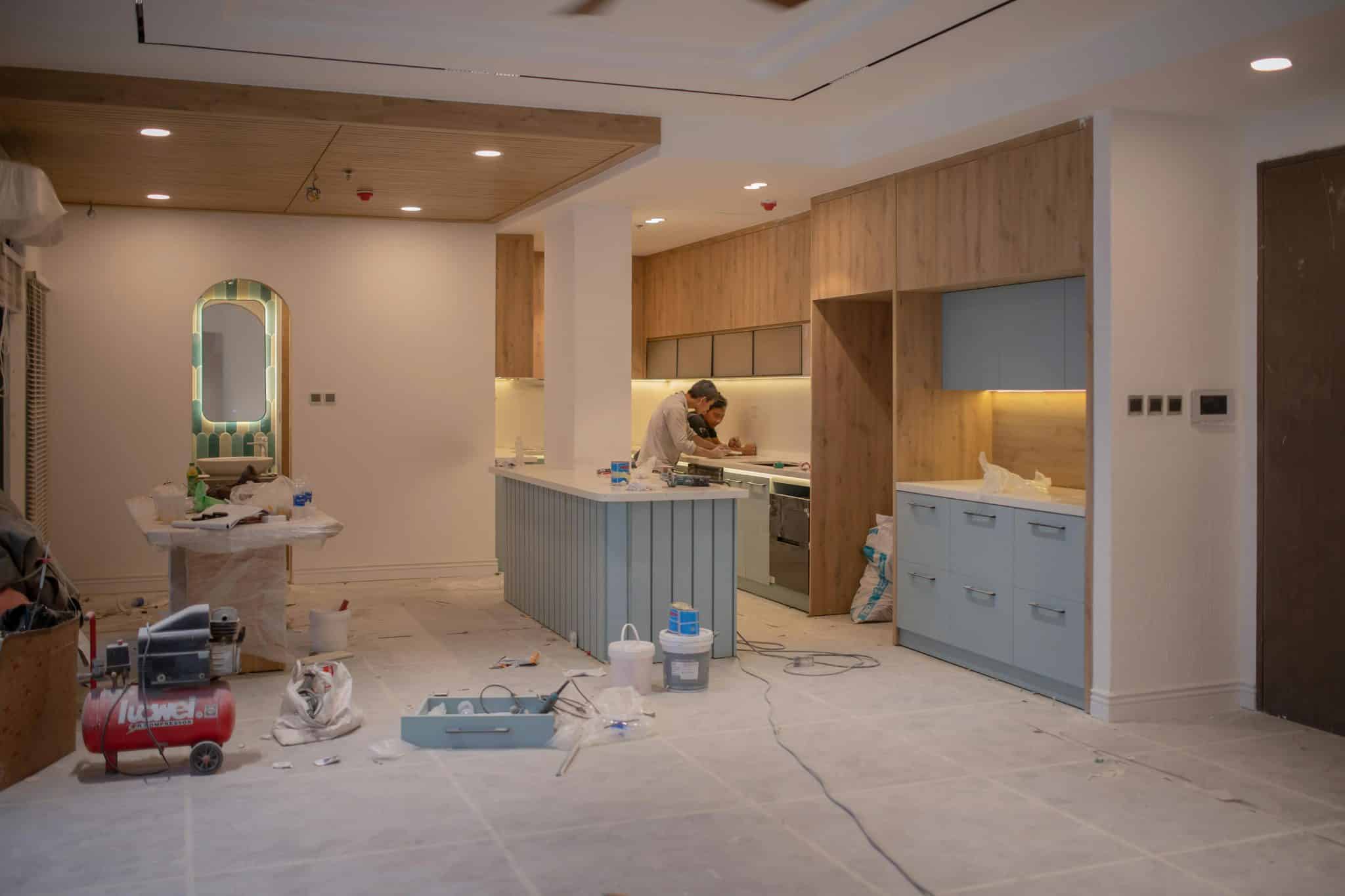You walk into your living room and freeze. There’s a crack running across your ceiling.
Your heart starts racing. Is your house falling apart? Will the ceiling collapse? Should you pack up and leave tonight?
Take a deep breath. Most ceiling cracks are completely normal. Every house gets them as it ages and settles. But here’s what matters: knowing which cracks are harmless and which ones spell trouble.
Some ceiling cracks are merely cosmetic annoyances that can be ignored.
Others are red flags screaming for immediate attention. The difference could save your family from danger and your wallet from disaster.
This guide shows you exactly when to worry about ceiling cracks and when to relax.
Why Do Ceiling Cracks Appear?
Ceiling cracks appear for various reasons. Most homes get small cracks over time. Your house moves and shifts as it ages. Weather changes make materials expand and contract.
Sometimes the problem starts during construction. Understanding what causes these cracks helps you know when to take action.
Common Causes of Ceiling Cracks:
- Natural settling of the house – New homes shift and settle into their foundation during the first few years, creating small cracks that are usually harmless.
- Humidity and temperature changes – Hot and cold weather make drywall expand and shrink, leading to hairline cracks at joints and seams.
- Poor workmanship – Rushed construction or the use of low-quality materials often results in visible cracks within months of moving in.
- Water damage or leaks – Moisture from roof leaks or plumbing issues weakens ceiling materials, creating brown-stained cracks.
- Structural movement or foundation shifts – Serious foundation problems cause wide cracks that run across ceilings and down walls.
Types of Ceiling Cracks and Their Causes
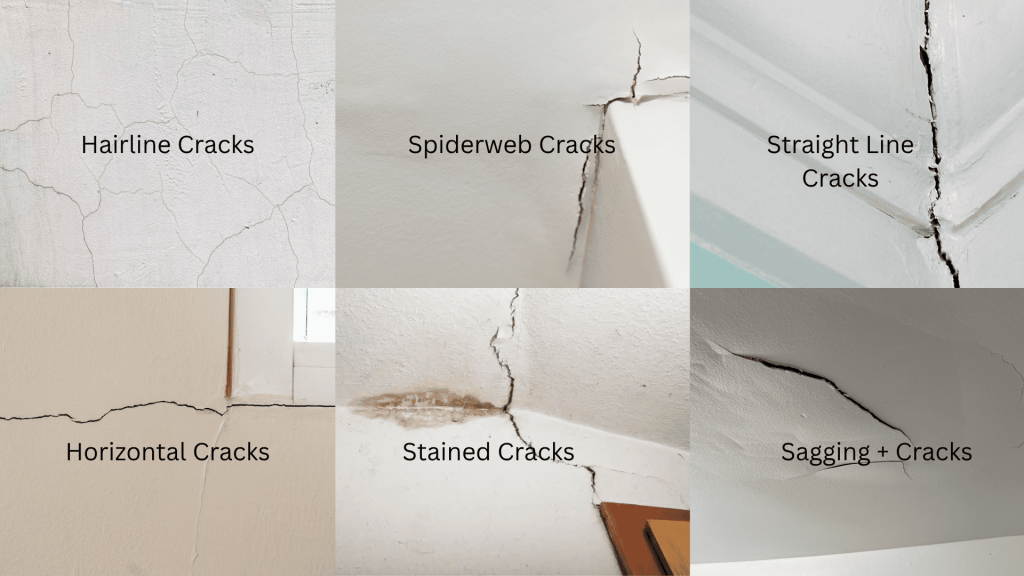
Understand the different types of ceiling cracks, their causes, and how to determine which ones require professional attention.
| Crack Type | Description | Common Cause |
|---|---|---|
| Hairline Cracks | Thin, surface-level cracks often under paint or plaster | Drying plaster, settling |
| Spiderweb Cracks | Small cracks radiating from the center, like a web | Poor plastering or fast drying |
| Straight Line Cracks | Cracks along drywall seams or ceiling joists | Joint movement, framing shift |
| Horizontal Cracks | Cracks running side-to-side, sometimes across walls too | Structural movement, truss uplift |
| Stained Cracks | Cracks with brown or yellow water marks | Water leaks (roof/plumbing) |
| Sagging + Cracks | Cracks on a bulging or drooping ceiling | Ceiling failure, moisture damage |
Ceiling Crack Patterns: What They Reveal
The direction and location of cracks tell you what’s happening inside your home.
Vertical cracks typically indicate normal settling and are generally less concerning.
Horizontal cracks often indicate structural stress and require prompt attention.
Diagonal cracks can indicate foundation movement or uneven settlement.
Cracks that follow seams in drywall or plaster are typically cosmetic issues from poor installation or normal house movement – these are the easiest and cheapest to fix.
When to Worry About Ceiling Cracks
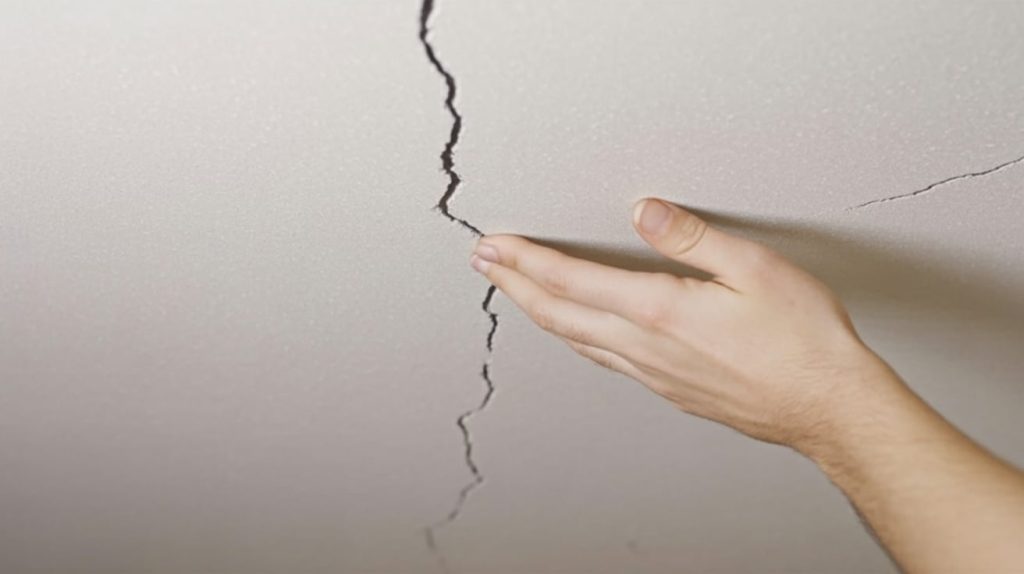
Not all ceiling cracks are serious, but some signal deeper structural or moisture problems. Learn how to identify the warning signs that require immediate attention.
1. Cracks Wider than 1/8 Inch
These wide cracks mean serious structural problems. You can fit a dime into cracks this size. They often grow bigger over time. Call a structural engineer right away. Don’t wait for them to get worse.
2. Cracks Running Across the Ceiling and Down Walls
This pattern shows major foundation movement. The crack forms a continuous line through your house.
It signals uneven settling or soil problems. Professional inspection is needed immediately. This type can affect your home’s safety.
3. Cracks with Water Stains or Mold
Brown or yellow stains around cracks mean active leaks. Mold grows quickly in wet conditions. These cracks can pose health risks to your family.
Fix the water source first, then repair the crack. Ignore this at your own risk.
4. Sudden Appearance of Large or Multiple Cracks
New cracks that appear overnight are severe warning signs. Multiple cracks in one area mean rapid structural changes.
This could indicate foundation failure or major settling. Document with photos and call experts immediately. Time is critical with sudden changes.
5. Ceiling Feels Soft, Saggy, or Bulging
Gently touch the ceiling around cracks to check for firmness. Soft spots mean water damage or structural failure.
Sagging indicates the ceiling might fall. Bulging shows pressure from above. Leave the room and call professionals right away.
6. Sound of Creaking or Shifting Near the Crack
Strange noises from cracks mean active movement. You might hear popping, creaking, or shifting sounds. This shows ongoing structural stress.
The problem is getting worse in real time. Professional help is needed before damage spreads.
Ceiling Crack: Fix It Yourself or Call a Pro?
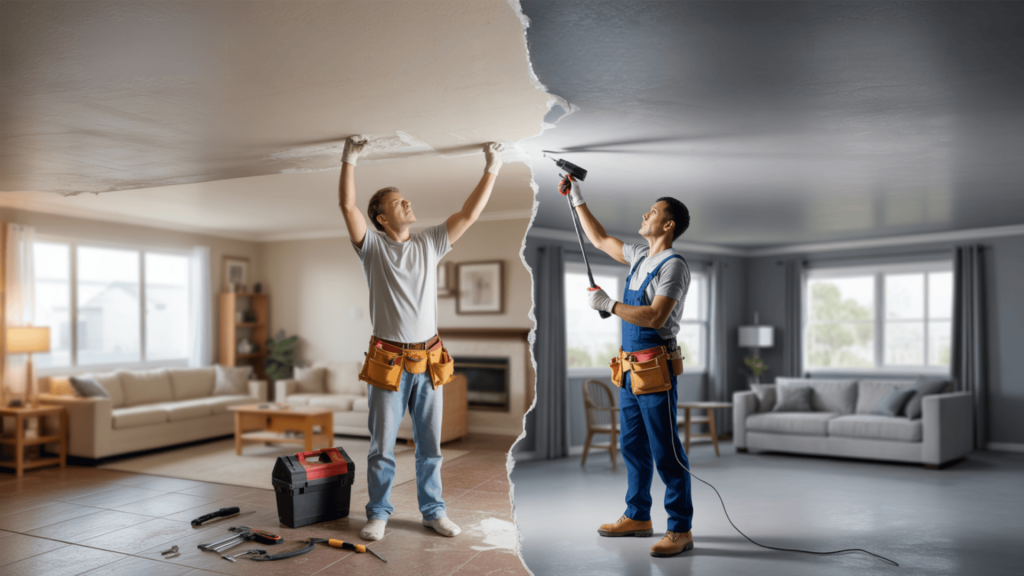
Not all ceiling cracks require professional help, learn how to tell which ones you can safely repair and which demand expert attention.
| Situation | What You Can Do | When to Call a Pro |
|---|---|---|
| Hairline or small cracks | Patch and paint if stable | If cracks reappear or spread |
| Crack near the drywall joint | Retape and skim coat if not widening | If it grows or forms new branches |
| Wide cracks | Avoid DIY unless experienced | Always, a possible structural issue |
| Cracks with stains or discoloration | Only after confirming the leak is fixed | If there is an active leak, mold, or no clear source |
| Crack continues on the wall | Not suitable for DIY | Structural movement is likely to need expert assessment |
| The ceiling is sagging or soft | Don’t touch, it could collapse | Urgent inspection required |
Ceiling Crack Repair Options
- Cosmetic repairs: plaster, joint compound Small hairline cracks can be fixed with mesh tape and joint compound for $50-150, or plaster patching for slightly deeper cracks.
- Structural reinforcement Major structural cracks require professional beam reinforcement, foundation repair, or ceiling replacement costing $2,000-15,000 depending on severity.
- Cost breakdown of different repairs DIY cosmetic fixes cost $20-100 in materials, professional cosmetic repairs run $200-500, while structural repairs range from $1,000-20,000 based on damage extent.
How to Stop Cracks in the Future?
Stopping ceiling cracks before they start saves money and stress. Keep your home’s humidity between 30-50% using dehumidifiers or humidifiers as needed.
Check your roof, gutters, and plumbing twice a year for leaks that could compromise the integrity of your ceiling materials.
Maintain steady indoor temperatures and avoid sudden changes in heating or cooling that cause materials to expand and contract.
Schedule professional inspections every 3-5 years for older homes to catch foundation or structural issues early, before they develop into serious ceiling problems.
Conclusion
Ceiling cracks don’t have to keep you awake at night. Most are harmless signs of normal house settling.
Remember the key warning signs: cracks wider than 1/8 inch, water stains, sagging areas, or cracks running from the ceiling to the walls. These need immediate professional attention.
For small hairline cracks, simple monitoring works fine. Take photos every few months to track any changes. Maintain a stable humidity level in your home and inspect for leaks regularly.
When in doubt, trust your instincts. A quick inspection by a structural engineer costs far less than major repairs later. Your family’s safety is worth the peace of mind.
What ceiling cracks have you noticed in your home recently?
Ready for a refresh? Explore more home improvement ideas to upgrade your space.
Frequently Asked Questions
How Do you Know if a Crack in the Ceiling Is Serious?
A ceiling crack is severe if it’s wider than 1/8 inch, has water stains, runs from the ceiling to the walls, or appears alongside sagging areas.
What Do Structural Ceiling Cracks Look Like?
Structural ceiling cracks are wide, long, and often run continuously from the ceiling down the walls, sometimes forming an L-shape or straight line across rooms.
How Much Does It Cost to Fix Cracks in a Ceiling?
Minor cosmetic ceiling crack repairs cost $100-300, while significant structural crack fixes can range from $1,000-10,000, depending on the underlying problem.
Does Insurance Cover Ceiling Cracks?
Insurance typically covers ceiling cracks caused by sudden events, such as storms or burst pipes, but not cracks resulting from normal settling or poor maintenance.

